Abstract
An improved variety of Macherla sheep were distributed to rural farmers in Guntur district to improve their livelihood during COVID-19 crisis. In the present study a total of 102 sheep were equally distributed to 17 BPL beneficiary families of rural areas of Guntur district. Each unit comprised of two Rams and four ewes. Prior to distribution a training programme was organized to educate the shepherds on management and disease prevention in Macherla sheep. The study was carried out from January 2020 to June 2021 and the data on production performance of Macherla sheep i. e body weights at different ages, litter size, mortality rate and mutton production was collected from 17 shepherds through semi structured interview schedule. Macherla sheep achieved an average body weight of 35 kgs at 12 months of age, with litter size one and mortality rate 4%. The average mutton production was 20 Kgs/ sheep. The result revealed a significant increase in income @ 41, 600/- per family/ annum by sale of sheep and mutton and also a significant increase in consumption of mutton among below poverty line (BPL) families. Moreover, rearing Macherla sheep enhanced the confidence levels of poor farmers, weaker sections of society and rural women by generating income source for themselves.
Key words: Rural farmer, Shepherds, Macherla sheep, Livelihood
Introduction
Sheep farming is an age old practice in rural India. Much of the sheep farming comprises of rearing local breeds with poor production performance. The average productivity of local breeds in terms of meat production is only 15 kgs/ sheep. However sheep production can easily be boosted up with improved varieties of sheep and can promise a better livelihood to the farmers. In southern peninsular India, most sheep are of meat type and they are reared only for mutton production (Acharya, 1982). Rearing of Macherla sheep is an important source of livelihood for rural people of Guntur district in Andhra Pradesh. The most preferred quality mutton is obtained from Macherla sheep, which is sold at a premium market price. Rearing of sheep has improved food security and the economic status of BPL families in Southern India (Bacchu et al., 2020). The growing demand for mutton and low investment in sheep sector provides opportunity for the rural farmers and women to obtain supplementary income for the family. However, the problems of low weight gain are some of the hindrances in sheep production which need to be overcome through introduction of improved variety of sheep with better performance levels. Hence, the present study was undertaken to determine the performance of Macherla sheep and its impact on the livelihood and nutritional security of BPL families in rural areas of Guntur district in Andhra Pradesh.
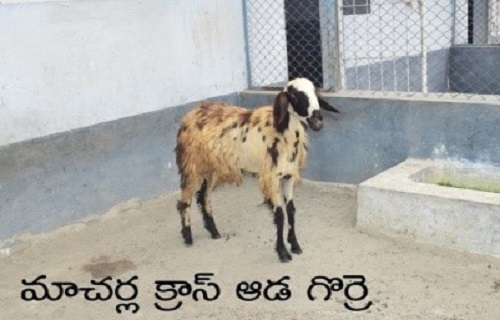

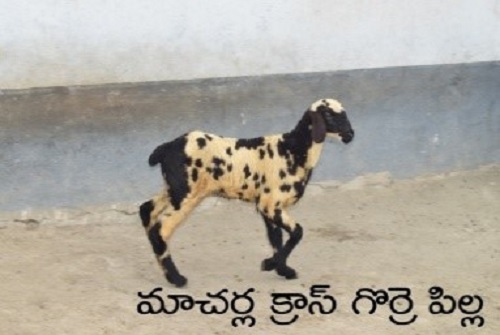
Materials and Method
Macherla sheep were reared in sheds made of concrete flooring system with open paddock and asbestos roof at Krishi Vigyan Kendra, Lam, Guntur upto the age of 1 year and 6 months on balanced diet as per the recommended protocol. In the present study a total of 102 sheep were equally distributed to 17 BPL beneficiary families of rural areas of Guntur district. Each unit comprised of two Rams and four ewes. Prior to study, a training programme was organized to educate the shepherds on management and disease prevention in Macherla sheep. The study was carried out from January 2020 to June 2021 and the data on production performance of Macherla sheep like body weights at different ages, litter size, mortality and mutton production was collected from shepherds through semi structured interview schedule and the data was statistically analysed (Snedecor and Cochran, 1989).
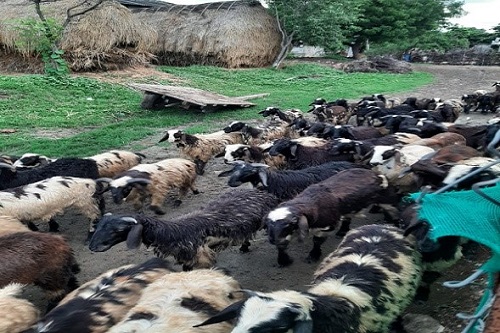
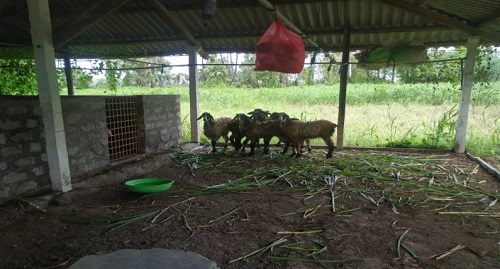
Results and Discussion
Body weight at different ages
Perusal of table 1 revealed that in majority of the shepherds (52.94%) observed the body weight of 3 kgs at birth. Reddy et al (2018) recorded data on body weight (i.e. at birth, 3, 6, 9 and 12 month) of 5044 Nellore Jodipi sheep in order to study the effect of non-genetic factors on growth traits. The average weights at birth, 3, 6, 9 and 12 months of age were 3.03 ± 0.01, 13.29 ± 0.07, 17.86 ± 0.10, 21.34 ± 0.12 and 24.96 ± 0.15kg, respectively.
Majority of the shepherds (52.94%) gained a body weight of 15 kgs at 3 months of age. With average body weight gain/day is 130g/ day. The present findings are in close agreement with Ekambaram et al (2013) who reported a body weight of 13.32 ± 0.13kg in Nellore (Jodipi) breed under farm conditions
Majority of the sheperds (47.05%) gained a body weight of 19 kgs at 6 months age .The present findings are in close agreement with Ekambaram et al (2013) who reported a body weight of 19.58± 0.22kg in Nellore (Jodipi) breed under farm conditions and studied the effect of non-genetic factors like year, sex and season on body weights. The effect of year of lambing and sex of lambs had significant (P≤0.01) influence on body weights at birth, 3, 6, 9 and 12 months of age, while season of breeding influenced significantly (P≤0.01) the body weights of animals at all ages except at 6 months of age. Males have shown superiority over females in respect of body weight at all ages studied.
Majority of the shepherds (47.05%) observed the body weight of 25kgs at 9 months age. The present findings are also in agreement with Ekambaram et al (2013) who reported a body weight of 23.55 ± 0.32kg in Nellore (Jodipi) breed under farm conditions. Shinde et al (1995) also observed similar weight under farm conditions where the lambs were maintained on good quality established pasture.
Majority of the shepherds (58.82%) observed the body weight of 35 kgs at 12 months age. The results obtained are in agreement with Munir et al (2008) who observed significantly higher body weight among the intensively reared lambs compared to semi-intensive and extensively reared ones. However, the present findings are comparatively higher than the values reported by Ekambaram et al (2013) who reported a body weight of 27.36 ± 0.32kg in Nellore (Jodipi) breed under farm conditions. Bharambe and Bhurte (2012) compared Deccani lambs under grazing, semi stallfed and stall fed systems and found that the body weight,body length, body height, chest girth and total greasy fleeceyield was significantly higher (P< 0.01) in stall fed systemthan grazing and semi stall fed systems.
The higher body weights in sheep at different ages in the present study could be attributed to better managemental practices and feeding practices being adopted by the shepherds of this region and also the hands on training programme to the shepherds has further enhanced the confidence level among them.
Litter size
Majority of shepherds (58.82 %) observed a litter size of 1 per lambing and 5.88% shepherds observed twin lambing. Sharma et al (2004) reported that the average litter size at birth and weaning was 1.02 and 0.97 in Malpura ewes where as in GxM ewes it was 1.46 and 1.19, respectively.
Mortality rate
Majority of shepherds (58.82%) observed lamb mortality of 4%, 17.64% shepherds observed 8% lamb mortality and 23.53% shepherds observed 12% lamb mortality. Panduranga Reddy et al (2020) reported that the mortality rate among lambs upto 10% was recorded in 18.27% flocks, 11-20% mortality in 41.35% flocks and more than 20% lamb mortality in 40.38% flocks.
Mutton production
In the present study, 20 kgs mutton/sheep and 21 kgs/sheep was obtained from 64.70 % and 23.52% of shepherds, respectively at slaughter. However, few shepherds reported less than 20 kgs mutton/sheep (Table 1). Optimum mutton production in this study is might be due to better feeding and managemental practices being followed by the shepherds. Avivastra weaner lambs had achieved higher finishing weight in intensively (33.5Kg) fed lambs compared to semi- intensively (27.3 kg) fed lambs (Shinde et al., 1995). Pal et al (1997) reported that lambs reared under intensive system were superior to semi-intensive system with respect to mutton production. Girish et al (2012) reported significantly higher mean dressing percentage with 51.07±0.44% based on preslaughter weights (live weight) in lambs supplemented concentrate plus grazing, when compared to lambs in control group (grazing only) with 47.55±0.78% of dressing. In India, the average carcass yield obtained from sheep is low (12 kg/animal) in comparison to world average (15.6 kg/animal) because farmers mostly rear the animals on community lands without any supplementation (Singh et al., 2004). Hence, there is huge demand for mutton due to globalization and for the fulfillment of the demand; it becomes essential to improve the mutton quality of sheep (Kulkarni et al., 2008).
Table 1: Production parameters of Macherla sheep.
|
S. No. |
Parameters | Number of shepherds n =17 | Percentage |
SEM |
| 1. | Body weight at different ages | |||
| a. | Birth weight ( kgs) | |||
| 3.0 | 9 | 52.94 | 1.48 | |
| 2.0 | 5 | 29.41 | ||
| 1.5 | 3 | 17.64 | ||
| b. | 3 months (kgs) | |||
| 15.0 | 9 | 52.94 | 0.85 | |
| 13.0 | 6 | 35.29 | ||
| 11.0 | 2 | 11.76 | ||
| c. | 6 months ( kgs) | |||
| 20.0 | 4 | 23.52 | 0.5 | |
| 19.0 | 8 | 47.05 | ||
| 18.0 | 5 | 29.41 | ||
| d. | 9 months (kgs) | |||
| 30.0 | 5 | 29.41 | 0.5 | |
| 25.0 | 8 | 47.05 | ||
| 23.0 | 4 | 23.52 | ||
| E | 12 months | |||
| 40.0 | 3 | 17.64 | 1.83 | |
| 35.0 | 10 | 58.82 | ||
| 32.0 | 4 | 23.52 | ||
| 2. | Litter size | |||
| 1 | 16 | 94.11 | 2.29 | |
| 2 | 1 | 5.88 | ||
| 3 | 0 | 0 | ||
| 3. | Mortality rate | |||
| 4% | 10 | 58.82 | 2.17 | |
| 8% | 3 | 17.64 | ||
| 12% | 4 | 23.52 | ||
| 4 | Mutton produced (kgs) | |||
| 21.0 | 4 | 23.52 | 0.916 | |
| 20.0 | 11 | 64.70 | ||
| 19.0 | 2 | 11.76 | ||
Economics
Sheep grows on less input and provides alternate means of income for marginal farmers (Arora et al., 2016). The contribution of small ruminants is very valuable in rural areas (Ramesh et al., 2012). The major factors responsible for adoption of type of animal production system are climate and geographical conditions, while production cost is the important factor influencing the success of that system (Ocak et al., 2016). Income through sale of 2 ram lambs was Rs.15,600/- and sale of mutton from 2 adult males was Rs. 26000/- (@ 650/- per kg) was observed among majority of the shepherds (Table 2). The net profit /2 ram lambs and 2 adult male sheep /annum was Rs. 41, 100/- which was felt by the shepherds as an economically viable enterprise. The increased income over the rearing of local breed might be due to adoption of improved managemental practices leading to better productivity and reproductive performance of the Macherla sheep.
Table 2: Cost Economics of Macherla sheep.
|
S.No. |
Rs. |
|
| 1 | Night shelter, feed grains, vaccines (Rs. 50/- per sheep per annum) expenditure per shepherd | 500/- |
| 2 | About 40kgs mutton from 2 adult males @ 650/- per kg per annum | 26,000/- |
| 3. | By sale of minimum 2 ram lambs @ Rs. 650/-/ kg. (each lamb12 kg) | 15, 600/- |
| 4. | Net income per annum | 41, 600/- |
| 5 | Net profit per annum | 41, 100/- + 121.31/- |
The highest returns were mainly due to better sale price of mutton of adult male sheep and accompanied by less mortality rate of Macherla sheep during the study period. Porwal et al., (2006) reported that disposal of the finisher by slaughter provided 225, 266 and 303 percent higher income under extensive, semi intensive and intensive system than sale of live animals. Chaturvedi et al., (2010) reported that, the lambs of concentrate supplemented ewes were sold at higher rates (Rs. 1900/lamb) than those of non supplemented ewes (Rs.1400/lamb). Mahanthesh et al (2019) reported that performance and economics of Kenguri ram lambs and observed that they can be reared in intensive system with better income in semi-arid conditions of Karnataka.
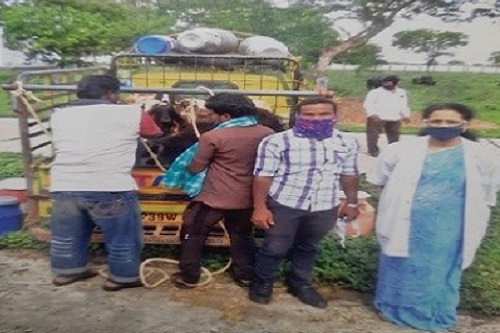
Conclusion
From the present study, it can be concluded that Macherla sheep performs better under field conditions to uplift socio economic status of BPL families. A significant increase in subsidiary income (@ 41, 600/- per Shepherd/annum) by sale of mutton and ram lamb was observed. It was also noticed that there was significant increase in consumption of mutton among shepherds families. The present study has achieved its goal by proper training and initiating income generating activity in shepherds and developed the entrepreneurial skills which helped in enhancing the self-esteem of rural people.
Reference
- Acharya R M (1982). Sheep and Goat breeds of India. FAO Animal Production and Health. Food and Agriculture Organisation of United Nations, Rome Italy. Pp: 121
- Arora R, Kulkarni V S, Jain A and Yadav D K (2016). Yalaga sheep- A microsatellite based genetic profile. Indian J of Animal Science. 86 (10): 1155 – 1158.
- Bacchu S, Meena K C, Deepa I and Meena G S (2020). Adoption of Improved Sheep Rearing Practices in the eastern part of Rajasthan, India. Int.J.Curr.Microbiol.App.Sci 9 (5): 271-277.
- Bharambe V Y and Bhurte R G (2012) .Comparative Growth Performance of Deccani Lambs under Various Rearing Systems in Agro-ecological Conditions of Konkan. Indian J of Hill farming. 25 (1): 44 -47.
- Chaturvedi O H, Mann J S and Karim S A (2010). Effect of concentrate supplementation to ewes grazing on community range land during late gestation and early lactation. Indian J of small Ruminants. 16 (1): 97-100.
- Ekambaram B, Alexander G and Kalyana Chakravarthi M (2013). Performance of Nellore sheep (Jodipi) under farm conditions. Indian Vet. J. 90 (12): 35-37.
- Girish P S, Baswa R P, Ramakrishna C, Ramana R Y, Satish C and Kondaiah N (2012). Effect of nutrient supplementation on growth performance and carcass characteristics of Nellore ram lambs-An on-farm evaluation study. Indian J of Animal Sciences. 82 (12): 1601.
- Kulkarni M D, Khanvilkar A V, Yadav G B, Khasnis M W and Ambore B N (2008). Sheep Management for Upliftment of Marginal Farmers. Veterinary World. 1 (12): 378-379.
- Mahanthesh M T, Kotresh Prasad C, Deepandita B, Pradeep Nag B S, Maneesh A and Narappa G (2019). Performance and economics of kenguri ram lambs under different rearing systems. Indian J of Animal Research. 53 (7): 984 – 987.
- Munir M, Jasra A W, and Rafique S. (2008). Lamb production under different systems of management on rangelands of Balochistan. Pakistan Vet. J. 28 (2): 68-70.
- Ocak S, Ogun S and Yilmaz O (2016). Dorper sheep utilizing feed resources efficiently: A Mediterranean case study. R. Bras zootec. 45 (8): 489-498.
- Pal U K, Agnigothri M K and Sinha N K (1997). Carcass traits of Muzaffarnagari lambs under intensive and semi intensive management systems. Indian J of Animal Science. 67: 720-722.
- Panduranga Reddy P, Vinoo R, Muralidhar M, Venkatasesaiah Ch, Aswani Kumar K and Sudhakar K (2020). Socio-economic Status, Sheep Husbandry Practices and Morphological Patterns of Macherla Sheep, a Lesser-known Sheep Breed of Andhra Pradesh. Journal of Animal Research: v.10 n.5, p. 827-835.
- Porwal K, Karim S A, Sisodia S L and Singh V K (2006). Relative economics of lamb rearing for mutton production under extensive, semi-intensive and intensive system of feeding management. Indian J. of Small Ruminants. 12 (1): 67-73.
- Ramesh D, Meena H R and Meena K L (2012). Analysis of Smallruminant market system in different agro-climatic zones of Southern India, Vet. World. 5 (5): 288-293.
- Reddy B V, Punyakumari B, Gowri Manokari V and Venkatramanan R (2018). Effect of Non- Genetic Factors on Growth Performance of farm bred Nellore Jodipi Sheep. Int. J. Pure App. Biosci. 6 (2): 1527 – 1531.
- Sharma, R C, Arora, A L, Mishra, A K, Kumar S and Singh V K (2004). Breeding Prolific Garole with Malpura Sheep for Increased Reproductive Efficiency in Semi Arid Tropics of India. J. Anim. Sci 2004. Vol 17, No. 6: 737-742).
- Shinde A K, Karim S A, Singh N P and Patnayak B C (1995). Growth performance of weaner lambs and kids under intensive and semiintensive feeding management. Indian J of Animal Science. 65: 830-833.
- Singh K P, Sankhyan S N and Prasad V S S (2004). Effect of supplementary concentrate on growth and carcass characteristics in crossbred sheep of dual purpose. The Indian J of animal sciences. 74 (8): 878-881
- Snedecor G W and Cochran W G (1989). Statistical methods. 6th Edition. Oxford Publishing Company. Calcutta, India.




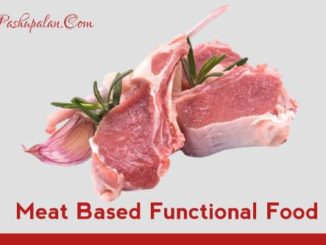
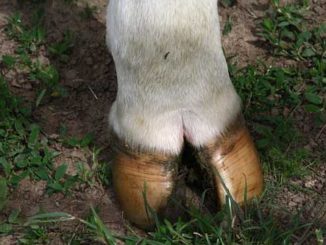
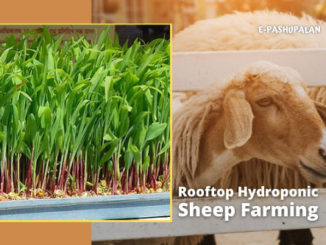

Be the first to comment